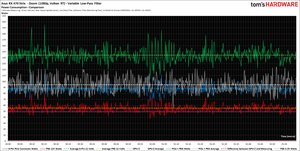AMD Radeon RX 470 4GB Review
Power Consumption
Measurement Methodology & Graphical Illustration
Taking into account the lessons learned from our follow-up measurements of AMD's Radeon RX 480 and your feedback, we made some fundamental changes to the way we measure power consumption.
Our measurement intervals are now twice as long. There's also a hardware-based low-pass filter and software-based variable filter in place (the latter is a feature of the software used to analyze data; it's designed to evaluate the plausibility of very short load peaks and valleys). The resulting curves are a lot smoother than the old ones; we hope you derive more value from them as a result.
You'll find more information about our power consumption test methodology in The Math Behind GPU Power Consumption And PSUs.
You'll find a larger number of bar graphs, and higher-resolution versions of our power consumption charts that you can expand by clicking on them. We restructured our topic sections, added more comparison bar graphs, and, finally, added different scenarios to our measurements. In addition to power consumption, we also examine current to determine whether the graphics card stays within all of its relevant specifications.
Our test equipment doesn't change, though:
| Power Consumption Measurement | |
|---|---|
| Test Method | Contact-free DC Measurement at PCIe Slot (Using a Riser Card) Contact-free DC Measurement at External Auxiliary Power Supply Cable Direct Voltage Measurement at Power Supply |
| Test Equipment | 2 x Rohde & Schwarz HMO 3054, 500 MHz Digital Multi-Channel Oscilloscope with Storage Function 4 x Rohde & Schwarz HZO50 Current Probe (1mA - 30A, 100 kHz, DC) 4 x Rohde & Schwarz HZ355 (10:1 Probes, 500 MHz) 1 x Rohde & Schwarz HMC 8012 Digital Multimeter with Storage Function 1 x Optris PI640 80Hz Infrared Camera + PI Connect |
Power Consumption at Different Loads
We're adding several games to our measurement suite, though the familiar Metro: Last Light benchmark turns out to be the Radeon RX 470's biggest challenge. It’s followed closely by Doom, which generates numbers that are almost as high. However, there’s a difference of less than 4W between Ashes of the Singularity and Metro: Last Light. This means that Asus’ graphics card is consistently running close to or at its limit.
The gray bar represents power consumption based on those load peaks that made it through our filters to the smoother curve. That bar doesn't have any practical significance since the peaks we measured are too brief for them to matter (even if the shortest-duration ones were already filtered out by this point).
Get Tom's Hardware's best news and in-depth reviews, straight to your inbox.
Power Connector Load Distribution
So, how is the load distributed across the power rails during a realistic gaming load and a stress test? We aren't including the motherboard's 3.3V rail in this discussion because it's barely used (up to 1W, but usually less than that).
The balance between the two 12V rails (the motherboard slot connector and the six-pin power connector) is a lot more important. Even though Asus' Strix RX 470 limits the load on the motherboard slot’s connector to well below its maximum, the six-pin connector has to provide a bit more than it’s supposed to, according to its specifications.
For anyone looking for the next big scandal, these results aren't pretty, and they were definitely avoidable. However, the worst thing that could happen would be Asus' Strix RX 470 not getting its PCI logo. Everything will be just fine.
We already contacted Asus in case it's possible to readjust the load distribution with a larger emphasis on the motherboard slot.The Strix RX 470 and its almost 145W just barely fit into the PCI-SIG’s specifications. After all, there are really just 66W + 75W available using one six-pin power connector. Even though a 150W ceiling is mentioned all of the time, that's only true when the motherboard is over-volted to end up at the slot connector's maximum tolerance.This doesn’t affect the Strix RX 470's functionality, and it certainly won’t damage any hardware. These results come nowhere near that. However, if an eight-pin power connector was supposed to be there, then perhaps that's what we should be seeing. Specifications are what they are, after all.
Here are the corresponding graphs for gaming and our stress test. Click on them for a larger version.


The PCI-SIG’s specifications only apply to current, meaning power consumption results don't tell the whole story. The current graphs below show that the motherboard slot’s connector comes in well below 5A. Given that the PCI-SIG’s specifications call for a maximum of 5.5A, this is certainly on the safe side. There’s even some headroom for that shift from the six-pin power connector to the motherboard slot suggested above.
Of course, there are corresponding large graphs for the current as well.


Power Consumption Comparison with Other Graphics Cards
Finally, we’d like to know how the Strix RX 470 stacks up against other graphics cards. We're using the peak power consumption numbers for this comparison because they're what the previous results consisted of.
Power consumption during gaming is significantly lower compared to AMD’s own Radeon RX 480. Still, it’s way too high in multi-monitor setups and during Blu-ray playback, especially when taking into account what’s possible these days. The card never reaches the 150W barrier. This is interesting for those who are looking to either upgrade an existing system or build a new one with limited power supply options. Overall, the card is pretty frugal for what it is.
MORE: Best Graphics Cards
MORE: Desktop GPU Performance Hierarchy Table
MORE: All Graphics Content
Current page: Power Consumption
Prev Page Tomb Raider, Division & Witcher 3 Next Page Frequency, Temperature & Noise






